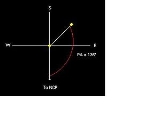
Position angle
Encyclopedia
Position angle, usually abbreviated PA, is a measurement derived from observing visual binary stars. It is defined as the angular offset in degree
s of the secondary star to the primary, relative to the north celestial pole
.
As the example illustrates, if one were observing a hypothetical binary star with a PA of 135 degrees, that means an imaginary line in the eyepiece
drawn from the north celestial pole (NCP) to the primary (P) would be offset from the secondary (S) such that the NCP-P-S angle would be 135 degrees.
When graphing visual binary orbits, the NCP line is traditionally drawn downward—that is, with north at bottom—and PA is measured counterclockwise, from 0 to 359 degrees.
Also the proper motion angle (see proper motion
) is sometimes called the position angle.
The definition of position angle is also extended to apply to extended objects like galaxies, where it refers to the angle made by the major axis of the object with the NCP line.
Degree (angle)
A degree , usually denoted by ° , is a measurement of plane angle, representing 1⁄360 of a full rotation; one degree is equivalent to π/180 radians...
s of the secondary star to the primary, relative to the north celestial pole
Celestial pole
The north and south celestial poles are the two imaginary points in the sky where the Earth's axis of rotation, indefinitely extended, intersects the imaginary rotating sphere of stars called the celestial sphere...
.
As the example illustrates, if one were observing a hypothetical binary star with a PA of 135 degrees, that means an imaginary line in the eyepiece
Eyepiece
An eyepiece, or ocular lens, is a type of lens that is attached to a variety of optical devices such as telescopes and microscopes. It is so named because it is usually the lens that is closest to the eye when someone looks through the device. The objective lens or mirror collects light and brings...
drawn from the north celestial pole (NCP) to the primary (P) would be offset from the secondary (S) such that the NCP-P-S angle would be 135 degrees.
When graphing visual binary orbits, the NCP line is traditionally drawn downward—that is, with north at bottom—and PA is measured counterclockwise, from 0 to 359 degrees.
Also the proper motion angle (see proper motion
Proper motion
The proper motion of a star is its angular change in position over time as seen from the center of mass of the solar system. It is measured in seconds of arc per year, arcsec/yr, where 3600 arcseconds equal one degree. This contrasts with radial velocity, which is the time rate of change in...
) is sometimes called the position angle.
The definition of position angle is also extended to apply to extended objects like galaxies, where it refers to the angle made by the major axis of the object with the NCP line.

